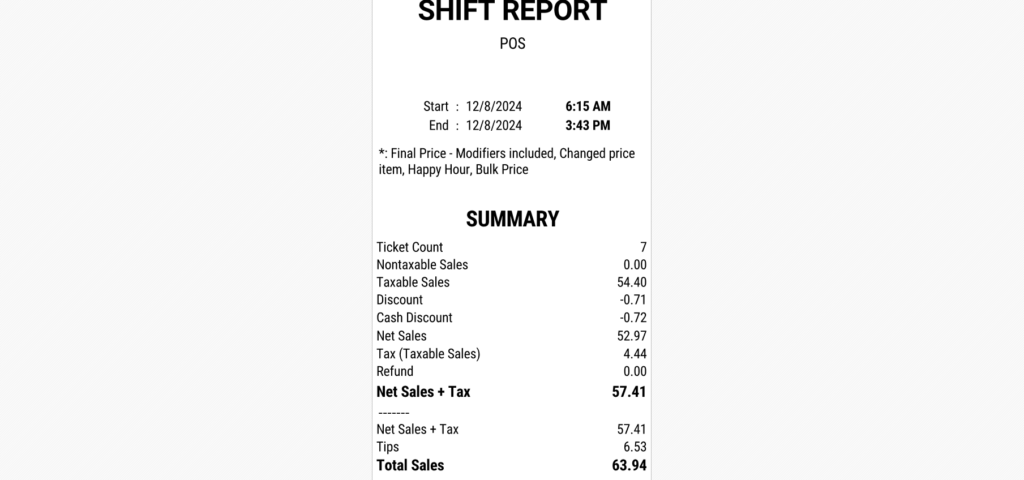Understanding your shift report is crucial for tracking sales, tips, and cash drawer accuracy. Below, we’ll break down each section of the shift report to help you interpret its data effectively.
A.Summary
This section provides an overview of key sales and payment metrics for the shift.

Ticket Count
The total number of tickets (orders) processed during the shift.
Nontaxable Sales
Sales that are not subject to tax, certain non-taxable items.
Taxable Sales
The total sales amount that is subject to tax.
Discount
The total value of discounts applied during the shift.
Cash Discount
The total amount of discounts specifically for cash payments.
Net Sales
Original price of items (taxable & non-taxable)) after subtracting discounts.
Tax (Taxable Sales)
The total tax collected on taxable sales.
Refund
The amount refunded to customers during the shift.
Net Sales + Tax
The total of net sales and tax combined.
Tips
The total tips received during the shift.
Total Sales
The grand total of sales, including tips and taxes.
B. Payment Type
This section breaks down the sales by payment method.

Tax Included, Service Charges & Tip Not Included
Shows the sales amount for each payment type, with tax included but excluding tips and service charges. All payment methods are listed in detail.
C. Credit Card (Tax Included)

Breakdown of sales made with credit cards, including tax.
Sales (Without Tip)
Total sales amount paid via credit cards, excluding tips after subtracting discounts (Net Sales + Tax – Discount).
Tips
The total tips received via credit card payments.
Total Sales
The sum of sales and tips for credit card payments.
Merchant Fee
The processing fee charged by the credit card company.
Deposit Amount
The net amount deposited after deducting merchant fees.
D. Cash Drawer (Cash)
Tracks the cash flow in the register during the shift.

Starting Cash
The cash amount in the drawer at the start of the shift.
Sales Paid by Cash
Total sales amount paid in cash (Net Sales + Tax – Discount).
Expected Cash
The total cash expected in the drawer at the end of the shift, including starting cash.
Counted by End-of-Shift
The actual cash counted at the end of the shift.
Expected Cash (Excluding Starting Cash)
The expected cash amount, excluding the starting cash balance.
E. Sale Type
Shows sales categorized by type of service.

Tax Included – Tips, Online Delivery Fee & Service Charges Not Included
Indicates that tax is included in the sales figures, but tips, delivery fees, and service charges are excluded.
To-Go
Sales for takeout orders.
Dine-In
Sales for dine-in orders.
F. Dine-In
Details about dine-in sales, excluding tips and service charges.

Count
Number of dine-in orders.
Taxable Sales
Total taxable sales from dine-in orders.
Sales Tax
Total tax collected on dine-in sales.
G. Item Type
Breakdown of sales by item type.

In the item type report section, it reports based on the item type defined in the product item. You can create a new item type or select an existing one.

Tax Included – Tips & Service Charges Not Included
Indicates that tax is included, but tips and service charges are excluded.
Total = Net Sales + Tax – Discount
The total sales amount, including tax, grouped by item type.
H. Tips Paid to Employee
Tracks the distribution of tips.

Tips
Total tips received during the shift.
Merchant Fee
Fees associated with tip transactions via credit card.
Deposit Tip
The net tip amount deposited after deducting merchant fees.
I. Tips by Payment Type
Breakdown of tips received based on payment method.

Credit
Total tips received via credit card payments.
J. Tips by Sale Type
Breakdown of tips received by service type.

To-Go
Tips received for takeout orders.
Dine-In
Tips received for dine-in orders.
K. Canceled
Tracks items or modifiers canceled after submission to the kitchen.

Count Items
Number of items canceled.
Count Modifiers
Number of modifiers canceled.
This guide should help you understand each section of the shift report and how to use the data effectively for financial and operational tracking.